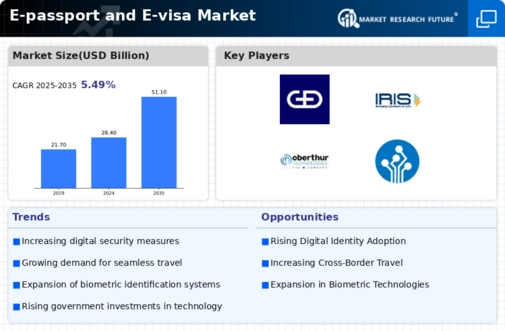Market Trends
Key Emerging Trends in the E-passport E-visa Market
The market trends in the E-passport and E-visa sector underscore a significant shift towards advanced technologies, increased digitalization, and a focus on enhancing the overall travel experience. One notable trend is the growing adoption of biometric authentication methods in E-passports and E-visas. Biometric technologies, such as fingerprints and facial recognition, are becoming integral components of electronic identification systems. This trend reflects the industry's commitment to leveraging biometrics for secure and efficient identity verification, contributing to enhanced border control and streamlined travel processes.
The increasing prevalence of digitalization is a key trend in the E-passport and E-visa market. Governments worldwide are embracing digital platforms to streamline visa application processes, reduce paperwork, and facilitate electronic issuance of travel documents. This trend aligns with the broader digital transformation in the travel and identification sectors, catering to the demand for online services, convenience, and expedited visa application procedures. The industry's adoption of digitalization trends contributes to a more seamless and user-friendly travel documentation experience.
A notable trend in the E-passport and E-visa sector is the emphasis on enhancing cybersecurity measures. As electronic identification systems become more interconnected and reliant on digital technologies, the risk of cyber threats and identity fraud increases. Governments and industry stakeholders are actively investing in robust cybersecurity solutions to safeguard sensitive data, secure data transmission, and protect against potential cyber attacks. This trend underscores the industry's commitment to maintaining the integrity and trustworthiness of E-passports and E-visas in the face of evolving cybersecurity challenges.
The rise of mobile applications and digital wallets for E-passports and E-visas is a noteworthy trend. Travelers are increasingly seeking digital solutions that allow them to store and manage their electronic identification documents securely on mobile devices. This trend reflects the industry's response to changing consumer preferences, providing convenient and accessible options for travelers to carry and present their E-passports and E-visas digitally. The integration of mobile applications aligns with the broader trend towards mobile-centric services in the travel and identification sectors.
Another significant trend in the E-passport and E-visa market is the exploration of blockchain technology for secure and tamper-resistant document verification. Blockchain's decentralized and immutable nature offers the potential to enhance the security and authenticity of electronic identification systems. This trend reflects ongoing efforts within the industry to leverage innovative technologies for ensuring the integrity of E-passports and E-visas, thereby addressing concerns related to document tampering and fraud.
The expansion of international collaborations and standardization efforts is a prominent trend in the E-passport and E-visa sector. To facilitate seamless cross-border travel, there is a growing emphasis on establishing common standards and interoperability among electronic identification systems. International organizations, such as the International Civil Aviation Organization (ICAO), play a key role in developing guidelines and promoting standardized practices. This trend highlights the industry's recognition of the importance of global cooperation in achieving consistent and interoperable E-passport and E-visa solutions.
The incorporation of artificial intelligence (AI) and machine learning (ML) technologies is an emerging trend in the E-passport and E-visa market. These technologies are being applied to enhance the accuracy and efficiency of identity verification processes. AI and ML algorithms can analyze biometric data, detect anomalies, and improve the overall reliability of electronic identification systems. This trend reflects the industry's adoption of advanced technologies to further strengthen security measures and streamline border control operations.
Increased attention to environmental sustainability is a developing trend in the E-passport and E-visa sector. Efforts are being made to minimize the environmental impact of electronic identification systems, such as reducing the use of physical documents and promoting eco-friendly practices. This trend aligns with broader sustainability initiatives in the travel industry, emphasizing the importance of responsible and environmentally conscious practices in the development and implementation of E-passports and E-visas.
The evolution of contactless and touchless technologies represents a growing trend in the E-passport and E-visa market. Contactless solutions, such as RFID (Radio-Frequency Identification) and near-field communication (NFC), enable secure and convenient identification processes without physical contact. This trend responds to the increasing demand for hygiene-conscious and efficient travel experiences, especially in the context of the global pandemic. The industry's focus on contactless technologies reflects a commitment to meeting evolving customer expectations and ensuring safe travel procedures.







Leave a Comment